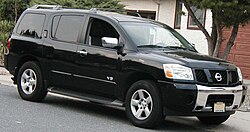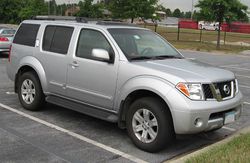| Nissan/Datsun 240Z | |
|---|---|
 | |
| Manufacturer | Nissan |
| Also called | Datsun 260Z Datsun 280Z Nissan Fairlady Z |
| Production | 1970–1978 |
| Predecessor | Datsun Sports |
| Successor | Nissan 280ZX |
| Class | Sports car |
| Body style(s) | 3-door hatchback |
| Layout | FR layout |
| Engine(s) | 2.4L SOHC I6 |
| Transmission(s) | 3-speed automatic 4-speed manual |
| Wheelbase | 90.7 in (2304 mm) |
| Length | 162.8 in (4135 mm) |
| Width | 64.1 in (1628 mm) |
| Curb weight | 2355 lb (1068 kg) |
| Designer | Yoshihiko Matsuo |
The S30 Nissan/Datsun 240Z (known in Japan as the Fairlady Z and later in other markets as the 260Z and 280Z) are sports cars produced by Nissan Motors, Ltd. of Japan in the 1970s. HLS30 was the designation of the left-hand drive model and HS30 for the right-hand drive model. The 240Z was introduced in 1969 with a 2.4 liter straight-6 engine, rear wheel drive, and a stylish coupe body. The engine, based on the Datsun 510's 4-cylinder produced 150 hp (112 kW) and came with a 5-speed manual transmission (USA model received a 4 speed manual). A 4 wheel independent suspension consisted of MacPherson struts in front (borrowed from the Datsun Laurel C30) and Chapman struts in back. Front disc brakes & rear drums were standard.
Production began in 1968, the 1970 240Z was introduced to the American market by Yutaka Katayama, president of Nissan Motors USA operations, widely known as 'Mr. K'. The early 1970 model 240Z had a chrome "240" badge on the B-pillar quarter panel. Two vents were included in the rear hatch below the glass molding. In mid-1971 the B-pillar side badges were restyled with the letter Z in white, and the vents were eliminated from the hatch. Design changes for the US model occurred throughout production and are described Design and Manufacturing Changes to the U.S. Spec
The 240Z and 260Z used twin one-barrel side-draft SU-like carburetors. The carburetors were changed beginning with model year 1973 to comply with emissions regulations, but the earlier carburetors were far superior for performance. Fuel injection (L-Jetronic electronic fuel injection, designed by Bosch) was added for the 280Z in 1975. This was primarily in order to cope with the difficulty faced in getting enough power using carburetors while still meeting US emissions regulations.
Due to its relatively low price compared to other foreign sports cars of the time (Jaguar and Porsche), it became hugely popular in the U.S. and was a major success for the Nissan Motor Corporation, which at the time sold cars in North America under the name Datsun. The 240Z also broadened the image of Japanese car-makers beyond their econobox success. The Z was very successful in racing in the 1970s (Bob Bondurant and his (Brock Racing Enterprises)BRE racing team, with John Morton driving a Datsun 510, number 46, was particularly successful). The Z is also credited as a catalyst for the current import performance parts industry.
In 2004, Sports Car International named this car number two on the list of Top Sports Cars of the 1970s.
Specifications
- Engine: 2393 cc (146 cu in) I-6, cast-iron block, alloy head, seven-bearing crankshaft, single overhead cam, 9.0:1 compression; Maximum recommended engine speed 7000 rpm.
- Bore: 83.0 mm (3.3 in)
- Stroke: 73.7 mm (2.9 in)
- Fuel system: Mechanical fuel pump, twin Hitachi HJG 46W 1.75 in (44.4 mm) SU-type carburetors
- Power: 151 hp (113 kW) at 5600 rpm (SAE gross)
- Torque: 146 lbf·ft (198 N·m) at 4400 rpm (SAE gross)
- Transmission: Four-speed manual, five-speed manual, or three-speed automatic (after September 1970)
- Final drive ratios:
- Four-speed manual transmission: 3.364:1 (37:11)
- Five-speed manual transmission: 3.90:1 (39:10) (not available in US)
- Three-speed automatic transmission: 3.545:1 (39:11).
- Brakes:
- Front: 10.7 in (271.8 mm) discs
- Rear: 9.0 in (228.6 mm) x 1.6 in (40.6 mm) drums
- Suspension:
- Front: Independent with MacPherson struts, lower links, coil springs, telescopic dampers, anti-roll bar
- Rear: Independent with Chapman struts, lower wishbones, coil springs, telescopic dampers
- Steering: Rack and pinion, 2.7 turns lock to lock
- Wheels: 4.5J-14 steel wheels with 175 SR 14 tires
- Wheelbase: 90.7 in (2303.8 mm)
- Length: 162.8 in (4135.1 mm)
- Width: 64.1 in (1628.1 mm)
- Dry weight: 2355 lb (1068 kg)
- Top speed: 125 mph (201 km/h)
- 0 to 60 mph (97 km/h): 8.0 s
- Typical fuel consumption: 21 mpg (U.S.) (11 L/100 km)
240ZG
The HS30-H Nissan Fairlady 240ZG was released in Japan in October 1971 to homologate the 240Z for Group 4 racing. Differences between the 240ZG and an export market Datsun 240Z include an extended fiberglass ‘aero-dyna’ nose, wider over-fenders riveted to the body, a rear spoiler, acrylic glass headlight covers and fender mounted rear view mirrors. The 240ZG was available in three colours: Grande Prix Red, Grande Prix White and Grande Prix Maroon. The "G" in 240ZG stands for "Grande." Although the ZG was never sold outside Japan, in order for it to be eligible for competition in the US, Nissan sold the nose kit as a dealer's option which is known as the "G-nose".
Z432
Packaging the S20(160hp) engine from the fire-breathing GT-R to help create a go-fast Fairlady. 432 referring to 4 valves per cylinder, 3 Carbs, and 2 cams. Approx. 420 were built.
Z432R
This is a sold in Japan only model Fairlady Z that was equipped with the twin cam 2.0L inline 6 cylinder "S20" engine shared with the KPGC10 Skyline GT-R. The Z432R was orange with black steel wheels and a low luster black hood. Z432R had lighter front guards, doors and bonnet and engine go faster bits than the Z432.
260Z
The engine was enlarged with a longer stroke to 2.6 L for the 260Z in 1974. A 2+2 seating option added with an extra 11.9 in of wheelbase. This engine was sold in the United States for the 1974 model year only, but was available in other countries until 1979. In the US, federal emissions regulations forced a reduction in ignition timing and compression ratio, resulting in a lower power output (140 hp) despite the additional displacement, whereas in other countries the power output actually increased to 162 bhp. A 3-speed automatic transmission was an option to the standard 4-speed manual.
Some USA residents regard the late model 260Z as the least desirable of the line, because of the reduced performance. This has resulted in lower prices on average for the late model 260Z.
The 260Z also claimed a few improvements over the 240Z. The climate controls were more sensibly laid out, and easier to work, and there was additional stiffness in the chassis due to a redesign of the chassis rails which were larger and extended further back than in the 240Z. The American model also featured heavier, safer, impact-absorbing bumpers.
Cosmetic changes included a redesigned Dashboard/Centre console, seat trim, door panels, and redesigned rear tail lights.
Specifications
- Engine: 2.6 L (158.7 cu in) I6, cast-iron block, alloy head, seven-bearing crankshaft, single over head camshaft
- Bore: 83.0 mm (3.3 in)
- Stroke: 79.0 mm (3.1 in)
- Compression Ratio: 9.0:1
- Fuel System: Mechanical fuel pump, twin Hitachi HMB 46 W 1.75 in (44.4 mm) SU-type carburetors
- Power: 162 hp (121 kW) at 5600 rpm
- Torque: {{auto lb ft|152 at 4400 rpm
- Transmission: Four-speed manual or three-speed automatic
- Brakes:
- Front: 10.7 in (271.8 mm) discs front
- Rear: 9.0 in (228.6 mm) X 1.6 in (40.6 mm) drums rear, servo assisted
- Suspension:
- Front: Independent with MacPherson struts, lower wishbones, coil springs, telescopic dampers, anti-roll bar
- Rear: Independent with MacPherson struts, lower wishbones, coil springs, telescopic dampers
- Steering: Rack and Pinion, 2.7 turns lock to lock
- Wheels/ Tires: 4.5J-14 steel wheels with 175 SR 14 tyres
- Wheelbase: 90.7 in (2303.8 mm)
- Length: 162.8 in (4135.1 mm)
- Width: 64.1 in (1628.1 mm)
- Dry Weight: 2425 lb (1100 kg)
- Top Speed: 127 mph (204 km/h)
- 0 to 60 mph (97 km/h): 8.0 sec
- Fuel consumption: 20 mpg (U.S.) (12 L/100 km) to 28 mpg (U.S.) (8 L/100 km)
280Z
Engine size was up again, to 2.8 L, by increasing the bore of the L26 engine for the 280Z in late 1975 to create the L28, and a reliable Bosch L-Jetronic fuel injection system was added. Heavier impact absorbing bumpers were added in 1975 (USA markets only). A 5-speed manual transmission was added as an option for the USA in 1977.
In 1975, larger, longer and heavier bumpers also known as "park benches" were added to meet strict safety standards.
In 1977 & 1978, Datsun offered a couple special edition models one being the "Black Pearl". The Black Pearl edition (produced only in 1978) came with Black Pearl paint and a "Special Appearance Package" (SAP), which consisted of dual racing mirrors, rear window louvers and a unique red and silver stripe-kit. It is estimated that somewhere between 750-1500 of these cars were produced. The "Zap" was offered in 1977 as a "Special Decor Package" edition with bright yellow paint and a big black stripe down the center and full length on the sides, with yellow, red and orange chevrons at front end of the stripes. It estimated that only 1000 "Zap Z" cars were offered in 1977 nation wide. The "Zap Z" model was also used as the pace car in the 1977 Long Beach Gran Prix.
Other non USA markets continued to receive the 260Z with the L26. Also, 280Z 2+2--the two-door, four-seat model.
The 280Z, although quite heavy and smog-controlled in stock form due to government regulations, was and is easily modified, with performance equaling much newer sports cars. For instance, simply removing the heavy front bumper and adding a front spoiler corrects the otherwise jittery high-speed handling of the stock version. Further, a great variety of aftermarket parts are available to, in effect, bring the 280Z back in line with the ethic of the early Z-cars, such as free-flowing exhaust/header kits and the installation of a 280zx turbo. The 280Z was a remarkable confluence of (1) a lightweight sports-car body and suspension relatively unchanged (sans bumpers) since 1970, and (2) a powerful and efficient engine similar in type to other great sportscars of various manufacture (approx. 3 litre, 12 Valve, straight six w/single overhead cam; e.g. Toyota Supra, BMW 3.0cs).
The S30 series Z car was replaced in 1979 by the S130 Nissan 280ZX



















![Validate my RSS feed [Valid RSS]](valid-rss-rogers.png)














































































